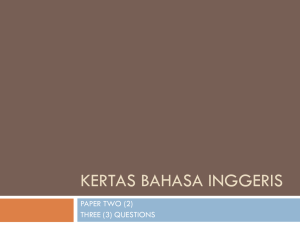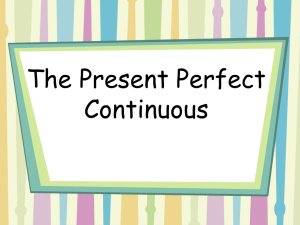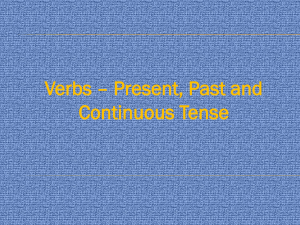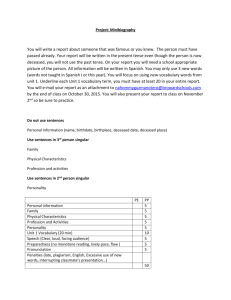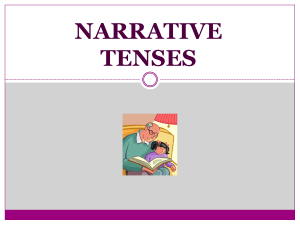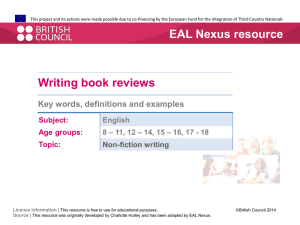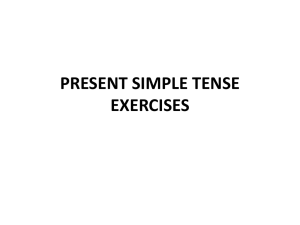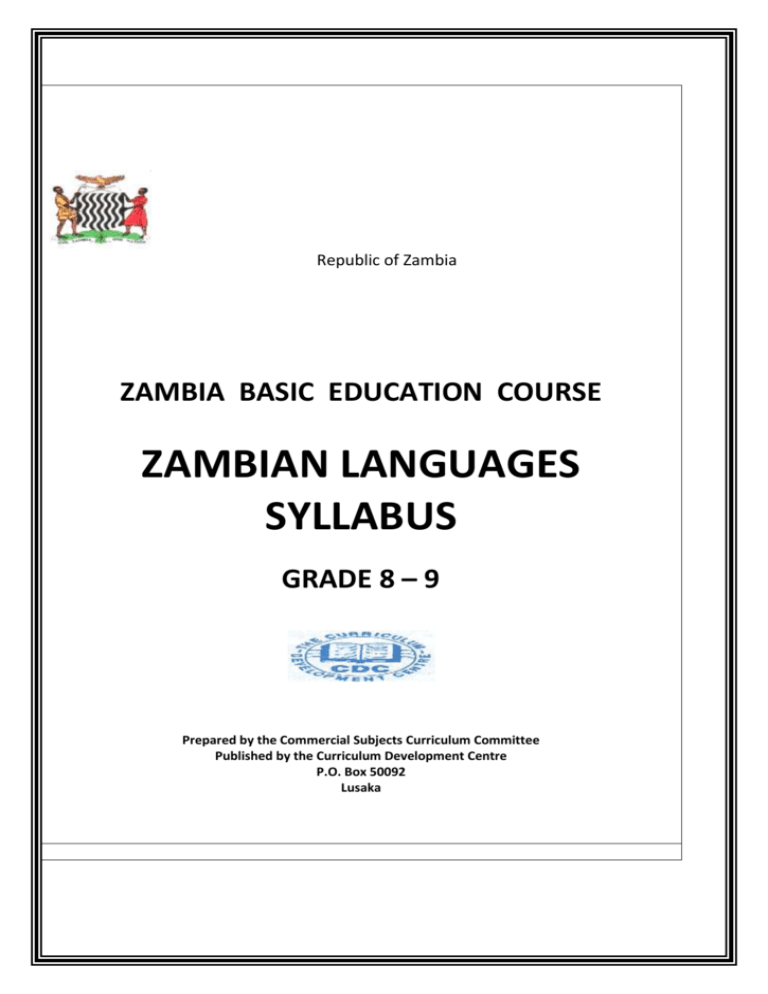
Republic of Zambia
ZAMBIA BASIC EDUCATION COURSE
ZAMBIAN LANGUAGES
SYLLABUS
GRADE 8 – 9
Prepared by the Commercial Subjects Curriculum Committee
Published by the Curriculum Development Centre
P.O. Box 50092
Lusaka
ZAMBIA BASIC EDUCATION COURSE
ZAMBIAN LANGUAGES
SYLLABUS
GRADE 8 – 9
Prepared by the Commercial Subjects Curriculum Committee
Published by the Curriculum Development Centre
P.O. Box 50092
Lusaka
(c) Curriculum Development Centre, 1997
All rights are reserved. No part of this syllabus may be reproduced, stored in a retrieval
Systems or transmitted in any form or by any means, electronic, mechanical, photocopying,
Recording, or otherwise, without the prior consent of the copyright owner.
TABLE OF CONTENTS
Page
Preface.......................................................................................................................
i
Acknowledgement....................................................................................................
ii
Introduction............................................................................................................. ..
iii
Production Skills .....................................................................................................
iv
Grade 8 Objectives ..................................................................................................
1
Grade 9 Objectives .................................................................................................
4
i
PREFACE
The Zambian Languages Syllabus is offered as an aspect of the Focus on Learning Education Policy
Implementation. In this regard, it is a unique contribution to the Zambian Curricular needs.
The Syllabus is planned against the background of the structure of the new school curriculum. This
text in particular, covers the Upper Basic Education category – Grade 8 – 9 and is cumulative as it
develops from grade to grade.
The most important aspects of the syllabus are the broad subject objectives. These among other
pursuits, promote thought, expression and communication. In addition, they develop the ability to
read, speak and write clearly as well as to develop essential skills, positive attitudes and knowledge
through the medium of Zambian Languages. Above all, the content of the syllabus aims at
inculcating the ability to apply and utilise the Zambian Languages for the total development of the
individual learner, the community and the Zambian Society.
Sichalwe M. Kasanda (Dr.)
Permanent Secretary
MINISTRY OF EDUCATION.
ii
ACKNOWLEDGEMENT
The curriculum review exercise would not have been accomplished without the involvement,
participation and commitment of many people. We want to thank all of them. Most importantly we
must thank UNICEF Area Office in Lusaka for financing the exercise. Secondly, we wish to thank all
the people, Government departments, and institutions of learning, Non-Governmental Organizations
of learning, Non-Governmental Organisations and Donor agencies who, in many varied ways,
contributed towards the production of this syllabus. These include all those who found time or were
able to allow their staff to attend the launching and/ or the report – back symposium during which
time CDC staff obtained useful information for the review process. We want to mention in particular
Professor M. Kashoki (UNZA), Dr. S.D. Kasanda (UNZA), Miss J. Chileshe (Zambia Environmental
Education Project) Mr. N.Phiri (Minsitry of Health), Fr. Flyn (UNZA), Mrs. M. Mwansa (Drug
Enforcement Commission) for preparing and presenting papers on various themes. Professor M.
Kashoki is sincerely thanked again for ably guiding the report-back symposium as a chairperson.
We are greatly indebted to the people who carried out the actual revisions at the review workshop.
These are Mr. G.N. Sililo (Ministry of Education) Mr. M. Katengo (Curriculum Development Centre),
Mr. K.M. Kaleyi (Curriculum Development Centre) Mr. S.M.L. Chimbaya (Inspectorate, Northern
Region, Kasama) Mr. B.C. Mwale (Inspectorate, Eastern Region, Chipata)Mr. B.H. Chisangano
(National In-Service Teacher Training College, Chalimbana) Mr. A. M. Kifita (Nkrumah Teachers’
College, Kabwe); Mrs. T. Sichula (Mumuni Primary School, Lusaka); Mrs. E. Zeko (Chankunkula
Schol, Lusaka), Mr. B.M. Mwendende (Curriculum Development Centre) Mr. L.M. Hamoonga
(Curriculum Development Centre); Mr. J.B. Kalipenta, (Curriculum Development Centre) and Ms. F.
Sakala, typist, (Curriculum Development Centre).
Finally we also wish to acknowledge indebtedness to the late Dr. C.D. Mkangaza, formerly Director
of the Curriculum Development Centre, for his valuable contributions in guiding the review exercise
on which the revision of this syllabus is based.
Emily F. Chingo
DIRECTOR
CURRICULUM DEVELOPMENT CENTRE
iii
INTRODUCTION
1.0.
The Basic Education Syllabus
Nothing could be more relevant to learners and more blending to their personality than to
learn in a language familiar to them.
The formulation of this syllabus has largely been necessitated by the lack of suffient guidance
in schools due to non availability of teaching and learning materials as indicated in the
Education Reform proposal of October, 1977 page 33 paragraph 28.
The syllabus reflects the major components in the teaching and learning situations within the
school system.
The major components reflected in this syllabus are: listening, speaking, reading and writing.
These are the four basic skills upon which each learner’s success lies.
2.0.
Complex Language Situation
Zambia is a multilingual society. One of the implied language complexity is that the syllabus
doe not treat Zambian Languages as first languages or mother tongues in areas where they are
taught. These languages take a function role in these areas because of the influx of other
nationalities and people transferring from one region to another.
3.0.
General Objectives
The syllabus aims at enabling the learners to:(a)
acquire the ability to express their feelings, thoughts, experiences and convictions
clearly and effectively in speech and writing.
(b)
read with understanding;
(c)
identify and promote good elements of the Zambian cultural heritage and integrate
them with accepted attitudes, ideals, values and habits of contemporary Zambia.
iv
PRODUCTIVE SKILLS
There are several productive skills in the syllabus that are easily noticeable; but only a few in
each grade have been reflected as examples. The following are the skills:
GRADE 8
Specific Objectives.
Learners should be able to (LSBAT)
1.
point out the most important points in a debate.
2.
analyse the themes and characters in a play.
3.
give directions.
4.
deliver a speech.
5.
create a poem.
6.
classify praises according to the purposes for which they are used.
7.
modify an interpretation from one language to another.
8.
plan and construct a convenient way to maintaining a diary.
9.
write a description of a class project.
GRADE 9
Specific Objectives.
Learners should be able to (LSBAT)
10.
differentiate (between) the functions of the future simple and future continuous tenses.
11.
use selected verbs in the future perfect tense.
12.
from the negative state of any verb.
13.
produce and correctly punctuate sentences containing the direct speech.
14.
list proverbs that apply to the situation.
15.
use personal and other pronouns according to the structural rules.
16.
classify nouns into their various noun classes.
GRADE 8 OBJECTIVES
GRADE VIII
8.
Aural and Oral Work – Reading, Writing and Language structure.
8.1.
Aural Work – Conversations, Speeches, Meetings and debates – Given the
opportunity to listen to conversations, speeches, meetings and debates, learners
should be able to (LSBAT):8.1.1
8.1.2
8.1.3
8.1.4
8.2.
reproduce what has been told to them orally or in writing
identify facts from opinions in conversations, speeches, debates or meetings
take notes of the proceeding of a meeting.
make a summary of arguments presented for and or against an issue.
Oral Work – drama, description, story-telling, poetry and songs – Given the
opportunity to express themselves in these aspects of oral work learners should be
able to (LSBAT):8.2.1
8.2.2
8.2.3
8.2.4
8.2.5
8.2.6
8.2.7
8.2.8
8.2.9
8.3.
dramatise events and stories.
analyse the theme and characters in a play.
develop a play on a given theme.
give directions and instructions.
describe a scenery, process or event.
select registers, dialects and accents to appropriate situations.
discuss principles of good story-telling.
make a story.
recite some praises, poem used for various village activities such as harvest,
funerals and festivals.
8.2.10 classify praises, poems and songs according to the purpose for which they are
used.
8.2.11 discuss the value of both traditional and modern songs.
8.2.12 create praises, songs, poems.
8.2.13 deliver a speech.
Reading –Intensive and extensive reading – Given the opportunity to read intensively
and extensively, learners should be able to (LSBAT):8.3.1
8.3.2
8.2.3
8.3.4.
answer surface and inference questions on a given passage.
list all difficult vocabulary, figures of speech and other language aspects.
explain vocabulary and language structure used in a passage.
interpret themes, characters, episodes with reference to themselves and
society.
1
8.4.
8.3.5
identify topics, styles, plots authors have employed.
8.3.6
analyse plots and styles of different authors.
Writing – Composition, reports, diaries and minutes, advertisements and stories.
Given the opportunity to practise writing these aspects, learners should be able to
(LSBAT):8.4.1
8.4.2
8.4.3
8.4.4
8.4.5
8.4.6
8.4.7
8.4.8
8.4.9
8.4.10
8.4.11
8.4.12
8.4.13
8.4.14
8.5.
write an autobiography.
write a formal and an informal letter.
write a composition on a number of school and home experiences
compose an essay on a topic of his/her own choice (free response)
translate sentences from English into a local language and vice-versa.
write a report on a selected topic.
begin and maintain a diary of his/her own after having read a selection of
entries from several Zambian diaries.
plan and construct a convenient way to maintain a diary as a record.
write minutes of a meeting
plan and write an advertisement or notice or poster.
discuss merits and demerits of advertisements.
write a story on a given topic.
explain various stories.
break down a story into its main parts.
Language Structure – Vocabulary, verb and tense – Given the opportunity to study
the language structures, learners should be able to (LSBAT):8.5.1
8.5.2
8.5.3
8.5.4
8.5.5
8.5.6
8.5.7
8.5.8
list words in various non class system.
make nouns from verbs and verbs from nouns.
identify concrete, countable and abstract nouns.
use prefixes, infixes, suffixes to build words.
list idiophones associated with colour and condition.
discuss words and expressions in terms of denotation (real) and connotation
(implied).
use simple present tense to express habitual action.
distinguish between simple present and present continuous tense.
2
8.5.9
write sentences in the simple present tense.
8.5.10 change sentences in other tenses into simple present tense.
8.5.11 use selected verbs in the present perfect tense.
8.5.12 use present perfect tense to construct sentences.
8.5.13 re-arrange sentences from other tenses into the present perfect tense.
8.5.14. use verbs in the present continuous tense
8.5.15 construct sentences in the present continuous tense
8.5.16 re-arrange sentences from other tenses so that they are expressed in the
present continuous.
8.5.17 select verbs in the simple past tense and use them in sentences.
8.5.18 re-arrange several sentences so that they are expressed in the simple past
tense.
8.5.19 produce a passage in the simple past tense.
8.5.20 use the past continuous tense for actions in the past which continue after a
particular time
8.5.21 change sentences in other tenses into past continuous tense.
8.5.22 use selected verbs in past continuous tense
8.5.23 differentiate past continuous from simple past tense.
8.5.24 use selected verbs in the past perfect tense
8.5.25 re-arrange sentences so that they are expressed in the past perfect tense.
8.5.26 distinguish between the past perfect and the simple past tense, verb
formations.
8.5.27 recognise various forms of the future tense in selected list of sentences.
8.5.28 use selected verbs in simple future tense.
8.5.29 form future continuous tense.
8.5.31 use selected verbs in the future continuous tense.
8.5.32 change sentences into future continuous tense.
8.5.33 form the future perfect tense to express action which will have been
continuing for sometime.
8.5.34 use selected verbs in the future perfect tense.
8.5.35 re-arrange several sentences so that they are expressed in the future perfect
tense.
8.5.36 pick out adverbs from a given passage.
8.5.37 identify types of adverbs. i.e. place, time, manner, condition etc.
8.5.38 use adverbs in sentences.
3
8.5.39 pick out adjectives from a given passage.
8.5.40. distinguish between adjectives and adverbs.
8.5.41 use adjectives in sentences.
8.5.42 identify noun classes.
8.5.43 classify adjectives whose prefixes are determined by nouns in a sentence.
8.5.44 discuss reduplicated nouns.
8.5.45 use verbs to form nouns and vice-versa in sentences.
8.5.46 pick out personal pronouns in a given passage and show the nouns they are
related to.
8.5.47 discuss the functions of pronouns.
8.5.48. write figures of speech, proverbs, irony, simile and metaphor.
8.5.49 classify proverbs according to situations
the meaning of proverbs.
8.5.51 identify irony, simile and metaphor.
8.5.52 discuss features of direct speech.
8.5.53 state why indirect speech is used.
8.5.54 change direct into indirect speech.
8.5.55 change indirect speech into direct speech.
8.5.56 compose a passage of about ten lines in direct speech and punctuate it.
8.5.57 report an incident in indirect speech.
negative and positive statements.
8.5.59 write positive and negative verbs
8.5.60
change negative statements into positive ones.
8.5.61 change positive statements into negative ones
GRADE 9 OBJECTIVES
GRADE IX
9.
Aural and Oral Work – Reading, Writing and Language structure.
9.1.
Aural Work – Conversations, Speeches, Meetings and debates – Given the
opportunity to listen to conversations, speeches, meetings and debates, learners
should be able to (LSBAT):9.1.1
reproduce what has been told to them in writing or orally.
9.1.2
judge implications and inferences of a conversation.
9.1.3
distinguish fact from opinion in speeches, conversations and debates.
9.1.4
4
assess issues, problems, conclusions, resolutions or recommendations arising
from a meeting, debate speeches or conversation.
9.1.5
take minutes of a meeting or speech.
9.1.6
make generalisation on arguments and facts mentioned in a debate, meeting,
speech or conversation.
9.1.7
9.2.
judge attitudes of the participant in a conversation, speech, meeting or debate.
Oral Work – drama, description, praises, poetry and songs – Given the opportunity
to express themselves in any of these oral languages areas, learners should be able to
(LSBAT):9.2.1
improvise a one act play.
9.2.2
apply emphasis, exaggerated, irony understatement and imitation of accent
appropriate to the situation.
9.2.3
describe in appropriate language selected aspects of flora and fauna.
9.2.4
give directions, demonstrations, warnings, advice etc.
9.2.5
describe an event or a process
9.2.6
recite poems with adequate voice projection, rhythm, enunciation, emphasis,
understatement, exaggeration etc.
9.2.7
discuss meaning of words, expressions in a praise song or poem.
9.2.8
analyse aspects of rhymes and tongue – twisters.
9.2.9
discuss aspects of praises and songs in relations to entertainment, sorrow,
birth and funeral.
9.2.10 evaluate poems.
9.2.11 deliver a speech.
9.3.
Reading –Intensive and extensive – Given the opportunity to practise reading course
books and other reading materials, learners should be able to (LSBAT):9.3.3
compare surface and inference questions on a given passage.
9.3.2
identify and explain difficult language usage, vocabulary, figures of speech in
relation to the usage.
9.3.3
conduct a survey of available reading materials on a given topic.
9.3.4
evaluate aspects of literary in general such as drama, novel and poetry.
9.3.5
evaluate plots and styles of different authors.
9.3.6
compare themes of different novels and plays.
9.3.7
read passages for comprehension purposes.
5
9.4.
Writing – Composition, reports, diaries and minutes, advertisements and stories.
Given the opportunity to practise writing, learners should be able to (LSBAT):9.4.1 recall some aspects of an outstanding personal experience.
9.4.2
write an essay to assess personal experiences.
9.4.3
use principles of written composition to write an account of some aspect of
Zambian life on political, social and economic issues.
9.4.5
write a biography
9.4.6
discuss the usefulness of diaries, reports, minutes and advertisements.
9.4.7
write recommendations in a report
9.4.8
explain what has been done by the members, secretary, chairman of a
meeting for the minutes to be a valid record of the proceedings.
9.4.9
evaluate some diaries in a report.
9.4.10 translate a short passage from English into a local language and vice-versa.
9.4.11 create a story
9.4.12 evaluate a story
9.4.13 assess the value of traditional stories in modern Zambia.
9.5.
Language Structure – Vocabulary, verb and tense – adjectives, adverbs, noun
system and pronouns, direct/indirect speech. Given the opportunity to learn these
aspects of language , learners should be able to (LSBAT):9.5.1 write compound, reduplicated or homonymous words.
9.5.2
derive nouns from verbs and vice-versa
9.5.3
distinguish abstract, concrete and uncountable nouns.
9.5.4
associate idiophones and onomatopoeia words with their corresponding
sounds.
9.5.5
use the simple present to express habitual action given principles of verb
formation.
9.5.6
analyse a passage and identify instances where the present tense is used.
9.5.7
explain the difference between the simple present and other tenses in the
passage e.g. Icibemba: a –le-ly a ( - le – a) present tense a-ka-ly –a (-ka-a)
future
9.5.8
use selected verbs in present continuous tense.
9.5.9
re-arrange several sentences so that they are expressed in the present
continuous tense.
9.5.10 use the present perfect
9.5.11 use selective verbs to construct sentences in present perfect tense.
9.5.12 use the simple past tense for an action which was completed in the past.
9.5.13 make a passage in which only the simple past tense is used.
6
9.5.14 re-write sentences so that they are expressed in the simple past tense.
9.5.15 distinguish between the uses to which the simple past tense can be put and
the functions of other past tenses.
9.5.16 change sentences from the simple tense to other past tense.
9.5.17 identify the past continuous tense used in a selected composition.
9.5.18 formulate a passage where past continuous tense is used.
9.5.19 use the past perfect tense when a completed action precedes another in the
past.
9.5.20 distinguish between the past perfect and simple past tenses.
9.5.21 create a series of paragraphs using the past perfect tense.
9.5.22 use past tenses in a written composition.
9.5.23 form the future tense to express an anticipated action.
9.5.24 appraise the uses to which the simple future tense is put in a selection of the
simple future and future continuous.
9.5.25 differentiate between the functions of the simple and future continuous.
9.5.26 change sentences from the simple future tense into future continuous.
9.5.27 criticise the uses to which the future continuous tense has been put in selected
written and oral compositions.
9.5.28 analyse a composition of two or three paragraphs in which the future is used.
9.5.29 differentiate between the future perfect tense and the future continuous.
9.5.30 form the future perfect continuous tense.
9.5.31 judge a passage in terms of the appropriate use of tenses.
9.5.32 use adjectives correctly to qualify nouns.
9.5.33 distinguish between words which function both as adjectives and as adverbs
e.g. in Nyanja:“Bwino”, “Kale”
-
Kamanga ali bwino (adjective)
-
Anagwira nchitoyo bwino (adverb)
-
Munthu Wakale (adjective)
-
Kamanga wadya Kale nsima (adverb)
9.5.34 place adverbs in acceptable positions.
9.5.35 use reduplication to emphasise adverbs.
9.5.36 complete a list of appropriate adjectives which could qualify and agree
structurally with noun form.
7
9.5.37 classify nouns into their various noun classes.
9.5.38 identify Concordia prefixes of each noun class.
9.5.39 use the plural forms of nouns in various classes.
9.5.40 use the secondary forms of noun class prefixes like honorific, diminutive and
pejorative.
9.5.41 use personal and other pronouns according to appropriate structure rules.
9.5.42 relate pronouns in dependent clauses to the nouns which they refer to.
9.5.43 identify situation in which direct speech would be the most appropriate way
of reporting an incident or series of incidents.
9.5.44 write about an incident, either real or fictitious in which direct speech is used.
9.5.45 point out the precise uses to which direct and indirect speech have been put in
a given narrative.
9.5.46 form the negative state of verbs.
9.5.47 classify an assorted group of verbs according to positive or negative valences.
9.5.48 form positive counterparts of a given series of negative sentences.
9.5.49 evaluate the role of proverbs in language use.
9.5.50 create plausible proverbs.
9.5.51 use irony in speech and writing.
9.5.52 discuss the use of irony in language.
9.5.53 create and use similes
9.5.54 create and use metaphors.
9.5.55 distinguish between a simile and a metaphor
9.5.56 evaluate the role of irony, similes and metaphor in language.
8

